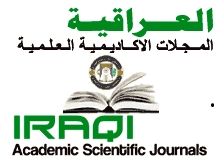Review article: Biodegradation of Pharmaceutical Pollutants: Challenges, Mechanisms, and Environmental Implications
DOI:
https://doi.org/10.56714/bjrs.50.2.8Keywords:
Pharmaceutical pollutants, biodegradation, environmental impact, bioremediation, Environmental ImplicationsAbstract
The emergence of such widespread pharmaceuticals as a pollutant has become one of the world's critical environmental problems that may lead to both the public's health and biodiversity deterioration. This article provides an exhaustive account of the current understanding of the environmental persistence of pharmaceutical contaminants following in-depth analysis of the additive effects of existing natural biodegradation pathways on the human health impact of these drugs. Paying special attention to biodegradation decomposing agents such as bacteria, fungi, and algae the paper estimates their ability to convert drug ingredients to compound that is eventually less toxic. Although these biologic systems contain an enormous potential for killing the unwanted pollutants, the variability in the complexity and endurance of the pharmaceutical substances overburden the degradation capabilities of these organisms thus necessitating improved biodegradation methods. Addressing the above-mentioned environmental factors, which include temperature, pH, and the occurrence of other contaminants, play a crucial role and have a direct impact that on the process of biodegradation, enhancing pollutants removal rate. To sum up, this paper enables the environmental science, microbiology and bioengineering enables creating progressively more functional and sustainable techniques of neutralizing these long-standing toxins; thus, protecting ecosystems, as well as human health.
Downloads
References
J. P. Fernandes, C. M. R. Almeida, M. A. Salgado, M. F. Carvalho, and A. P. Mucha, "Pharmaceutical compounds in aquatic environments—occurrence, fate and bioremediation prospective," Toxics, vol. 9, no. 10, p. 257, 2021.Doi: https://doi.org/10.3390/toxics9100257.
K. Chojnacka et al., "Biodegradation of pharmaceuticals in photobioreactors–a systematic literature review," Bioengineered, vol. 13, no. 2, pp. 4537-4556, 2022. Doi: https://doi.org/10.1080/21655979.2022.2036906.
I. Ivshina, G. Bazhutin, and E. Tyumina, "Rhodococcus strains as a good biotool for neutralizing pharmaceutical pollutants and obtaining therapeutically valuable products: Through the past into the future," Frontiers in Microbiology, vol. 13, p. 967127, 2022. Doi: https://doi.org/10.3389/fmicb.2022.967127.
H. B. Mansour, R. Mosrati, D. Barillier, K. Ghedira, and L. Chekir-Ghedira, "Bioremediation of industrial pharmaceutical drugs," Drug and Chemical Toxicology, vol. 35, no. 3, pp. 235-240, 2012. Doi: https://doi.org/10.3109/01480545.2011.591799.
M. Suleiman, F. Demaria, C. Zimmardi, B. A. Kolvenbach, and P. F.-X. Corvini, "Analyzing microbial communities and their biodegradation of multiple pharmaceuticals in membrane bioreactors," Applied Microbiology and Biotechnology, vol. 107, no. 17, pp. 5545-5554, 2023. Doi: https://doi.org/10.1007/s00253-023-12677-z.
Chhaya, T. Raychoudhury, and S. K. Prajapati, "Bioremediation of pharmaceuticals in water and wastewater," Microbial bioremediation & biodegradation, pp. 425-446, 2020. Doi: https://doi.org/10.1007/978-981-15-1812-6_16.
A. Xu et al., "Pollutant degrading enzyme: catalytic mechanisms and their expanded applications," Molecules, vol. 26, no. 16, p. 4751, 2021. Doi: https://doi.org/10.3390/molecules26164751.
R. Miglani et al., "Degradation of xenobiotic pollutants: an environmentally sustainable approach," Metabolites, vol. 12, no. 9, p. 818, 2022. Doi: https://doi.org/10.3390/metabo12090818.
A. Shah and M. Shah, "Characterisation and bioremediation of wastewater: a review exploring bioremediation as a sustainable technique for pharmaceutical wastewater," Groundwater for Sustainable Development, vol. 11, p. 100383, 2020. Doi: https://doi.org/10.1016/j.gsd.2020.100383.
H. Ali and E. Khan, "Trophic transfer, bioaccumulation, and biomagnification of non-essential hazardous heavy metals and metalloids in food chains/webs—Concepts and implications for wildlife and human health," Human and Ecological Risk Assessment: An International Journal, 2018. Doi: https://doi.org/10.1080/10807039.2018.1469398.
Y. Zhang, J. Guo, T. Yao, Y. Zhang, X. Zhou, and H. Chu, "The influence of four pharmaceuticals on Chlorellapyrenoidosa culture," Scientific reports, vol. 9, no. 1, p. 1624, 2019. Doi: https://doi.org/10.1038/s41598-018-36609-4.
P. Palma et al., "Pharmaceuticals in a Mediterranean Basin: The influence of temporal and hydrological patterns in environmental risk assessment," Science of the total environment, vol. 709, p. 136205, 2020. Doi: https://doi.org/10.1016/j.scitotenv.2019.136205.
Y. M. Alsayadi and S. Arora, "Impact of pharmaceutical pollutants on ecosystem-A Comprehensive review," in AIP Conference Proceedings, 2023, vol. 2558, no. 1: AIP Publishing. Doi: https://doi.org/10.1063/5.0122856.
M. Ortúzar, M. Esterhuizen, D. R. Olicón-Hernández, J. González-López, and E. Aranda, "Pharmaceutical pollution in aquatic environments: a concise review of environmental impacts and bioremediation systems," Frontiers in microbiology, vol. 13, p. 869332, 2022. Doi: https://doi.org/10.3389/fmicb.2022.869332.
D. Yadav et al., "Environmental and health impacts of contaminants of emerging concerns: Recent treatment challenges and approaches," Chemosphere, vol. 272, p. 129492, 2021. Doi: https://doi.org/10.1016/j.chemosphere.2020.129492.
J. Cheng et al., "Promoted reductive removal of chlorinated organic pollutants co-occurring with facilitated methanogenesis in anaerobic environment: A systematic review and meta-analysis," Critical Reviews in Environmental Science and Technology, vol. 52, no. 14, pp. 2582-2609, 2022.. Doi: https://doi.org/10.1080/10643389.2021.1886890.
N. Taghavi, I. A. Udugama, W.-Q. Zhuang, and S. Baroutian, "Challenges in biodegradation of non-degradable thermoplastic waste: From environmental impact to operational readiness," Biotechnology Advances, vol. 49, p. 107731, 2021. Doi: https://doi.org/10.1016/j.biotechadv.2021.107731.
M. F. Imron, S. B. Kurniawan, N. I. Ismail, and S. R. S. Abdullah, "Future challenges in diesel biodegradation by bacteria isolates: a review," Journal of Cleaner Production, vol. 251, p. 119716, 2020. Doi: https://doi.org/10.1016/j.jclepro.2019.119716
N. Mahesh et al., "A review on mitigation of emerging contaminants in an aqueous environment using microbial bio-machines as sustainable tools: Progress and limitations," Journal of Water Process Engineering, vol. 47, p. 102712, 2022. Doi: https://doi.org/10.1016/j.jwpe.2022.102712.
D. Berillo, A. Al-Jwaid, and J. Caplin, "Polymeric materials used for immobilisation of bacteria for the bioremediation of contaminants in water," Polymers, vol. 13, no. 7, p. 1073, 2021. Doi: https://doi.org/10.3390/polym13071073.
A. Pellis, S. Cantone, C. Ebert, and L. Gardossi, "Evolving biocatalysis to meet bioeconomy challenges and opportunities," New biotechnology, vol. 40, pp. 154-169, 2018. Doi: https://doi.org/10.1016/j.nbt.2017.07.005.
J. M. Woodley, "Accelerating the implementation of biocatalysis in industry," Applied Microbiology and Biotechnology, vol. 103, no. 12, pp. 4733-4739, 2019. Doi: https://doi.org/10.1007/s00253-019-09796-x.
R. Remya et al., "Role of nanoparticles in biodegradation and their importance in environmental and biomedical applications," Journal of Nanomaterials, vol. 2022, 2022. Doi: https://doi.org/10.1155/2022/6090846.
K. A. Loftin, C. D. Adams, M. T. Meyer, and R. Surampalli, "Effects of ionic strength, temperature, and pH on degradation of selected antibiotics," Journal of environmental quality, vol. 37, no. 2, pp. 378-386, 2008. Doi: https://doi.org/10.2134/jeq2007.0230.
T. Berger, C. Poyntner, and R. Margesin, "Culturable bacteria from an Alpine coniferous forest site: biodegradation potential of organic polymers and pollutants," Folia Microbiologica, vol. 66, no. 1, pp. 87-98, 2021/02/01 2021, Doi: 10.1007/s12223-020-00825-1.
E. De Bel, J. Dewulf, B. De Witte, H. Van Langenhove, and C. Janssen, "Influence of pH on the sonolysis of ciprofloxacin: biodegradability, ecotoxicity and antibiotic activity of its degradation products," Chemosphere, vol. 77, no. 2, pp. 291-295, 2009. Doi: https://doi.org/10.1016/j.chemosphere.2009.07.033.
V. Bernal, A. Erto, L. Giraldo, and J. C. Moreno-Piraján, "Effect of solution pH on the adsorption of paracetamol on chemically modified activated carbons," Molecules, vol. 22, no. 7, p. 1032, 2017. Doi: https://doi.org/10.3390/molecules22071032.
S. Wu, L. Zhang, and J. Chen, "Paracetamol in the environment and its degradation by microorganisms," Applied microbiology and biotechnology, vol. 96, pp. 875-884, 2012. Doi: https://doi.org/10.1007/s00253-012-4414-4
J. Żur, A. Piński, A. Marchlewicz, K. Hupert-Kocurek, D. Wojcieszyńska, and U. Guzik, "Organic micropollutants paracetamol and ibuprofen—toxicity, biodegradation, and genetic background of their utilization by bacteria," Environmental Science and Pollution Research, vol. 25, pp. 21498-21524, 2018. Doi: https://doi.org/10.1007/s11356-018-2517-x
K. Kümmerer, "The presence of pharmaceuticals in the environment due to human use–present knowledge and future challenges," Journal of environmental management, vol. 90, no. 8, pp. 2354-2366, 2009. Doi: https://doi.org/10.1016/j.jenvman.2009.01.023.
B. Tiwari, B. Sellamuthu, Y. Ouarda, P. Drogui, R. D. Tyagi, and G. Buelna, "Review on fate and mechanism of removal of pharmaceutical pollutants from wastewater using biological approach," Bioresource technology, vol. 224, pp. 1-12, 2017. Doi: https://doi.org/10.1016/j.biortech.2016.11.042.
P. Nguyen, G. Carvalho, M. A. Reis, and A. Oehmen, "A review of the biotransformations of priority pharmaceuticals in biological wastewater treatment processes," Water Research, vol. 188, p. 116446, 2021. Doi: https://doi.org/10.1016/j.watres.2020.116446.
M. H. Van Agteren, S. Keuning, and J. Oosterhaven, Handbook on biodegradation and biological treatment of hazardous organic compounds. Springer Science & Business Media, 1998. Doi: https://www.cabidigitallibrary.org/doi/full/10.5555/19991907752.
G. Zanaroli, A. Negroni, M. M. Häggblom, and F. Fava, "Microbial dehalogenation of organohalides in marine and estuarine environments," Current Opinion in Biotechnology, vol. 33, pp. 287-295, 2015. Doi: https://doi.org/10.1016/j.copbio.2015.03.013.
Y. M. Abd-Elhakim, M. M. Hashem, K. Abo-EL-Sooud, B. A. Hassan, K. M. Elbohi, and A. A. Al-Sagheer, "Effects of co-exposure of nanoparticles and metals on different organisms: a review," Toxics, vol. 9, no. 11, p. 284, 2021. Doi: https://doi.org/10.3390/toxics9110284.
E. Díaz, "Bacterial degradation of aromatic pollutants: a paradigm of metabolic versatility," 2004. Available: https://digital.csic.es/handle/10261/2134.
P. Alfonso-Muniozguren, E. A. Serna-Galvis, M. Bussemaker, R. A. Torres-Palma, and J. Lee, "A review on pharmaceuticals removal from waters by single and combined biological, membrane filtration and ultrasound systems," Ultrasonics sonochemistry, vol. 76, p. 105656, 2021. Doi: https://doi.org/10.1016/j.ultsonch.2021.105656.
H. Rafeeq et al., "Genetically engineered microorganisms for environmental remediation," Chemosphere, vol. 310, p. 136751, 2023. Doi: https://doi.org/10.1016/j.chemosphere.2022.136751.
B. Barooah, K. Sharma, and G. Kaushik, "Role of microbial enzymes in degradation of personal care products present in environmental matrices," Microbial Degradation and Detoxification of Pollutants, vol. 2, p. 21, 2023. Doi: https://www.degruyter.com/document/doi/10.1515/9783110743623002/pdf?licenseType =restricted
M. Bilal, M. Adeel, T. Rasheed, Y. Zhao, and H. M. Iqbal, "Emerging contaminants of high concern and their enzyme-assisted biodegradation–a review," Environment international, vol. 124, pp. 336-353, 2019. Doi: https://doi.org/10.1016/j.envint.2019.01.011.
N. T. Joutey, W. Bahafid, H. Sayel, and N. El Ghachtouli, "Biodegradation: involved microorganisms and genetically engineered microorganisms," Biodegradation-life of science, vol. 1, pp. 289-320, 2013. Doi: https://doi.org/10.1016/b978-0-12-823991-9.00001-0.
D. Kim and Y. Rhee, "Biodegradation of microbial and synthetic polyesters by fungi," Applied microbiology and biotechnology, vol. 61, pp. 300-308, 2003. Doi: https://doi.org/10.1007/s00253-002-1205-3.
A. Ceci, F. Pinzari, F. Russo, A. M. Persiani, and G. M. Gadd, "Roles of saprotrophic fungi in biodegradation or transformation of organic and inorganic pollutants in co-contaminated sites," Applied microbiology and biotechnology, vol. 103, no. 1, pp. 53-68, 2019. Doi: https://doi.org/10.1007/s00253-018-9451-1.
Q. Zhou, R. Li, T. Li, R. Zhou, Z. Hou, and X. Zhang, "Interactions among microorganisms functionally active for electron transfer and pollutant degradation in natural environments," Eco-Environment & Health, vol. 2, no. 1, pp. 3-15, 2023. Doi: https://doi.org/10.1016/j.eehl.2023.01.002.
C. Dai, H. Wu, X. Wang, K. Zhao, and Z. Lu, "Network and meta-omics reveal the cooperation patterns and mechanisms in an efficient 1, 4-dioxane-degrading microbial consortium," Chemosphere, vol. 301, p. 134723, 2022. Doi: https://doi.org/10.1016/j.chemosphere.2022.134723.
D. R. Olicón-Hernández, J. González-López, and E. Aranda, "Overview on the biochemical potential of filamentous fungi to degrade pharmaceutical compounds," Frontiers in microbiology, vol. 8, p. 256025, 2017. Doi: https://doi.org/10.3389/fmicb.2017.01792.
S. Gangola, S. Joshi, S. Kumar, and S. C. Pandey, "Comparative analysis of fungal and bacterial enzymes in biodegradation of xenobiotic compounds," in Smart bioremediation technologies: Elsevier, 2019, pp. 169-189. Doi: https://doi.org/10.1016/b978-0-12-818307-6.00010-x.
S. Karishma, P. Yaashikaa, P. S. Kumar, R. Kamalesh, A. Saravanan, and G. Rangasamy, "Promising approaches and kinetic prospects of the microbial degradation of pharmaceutical contaminants," Environmental Science: Advances, 2023. Doi: https://doi.org/10.1039/d3va00194f.
B. Xu, G. Xue, and X. Yang, "Isolation and application of an ibuprofen-degrading bacterium to a biological aerated filter for the treatment of micro-polluted water," Frontiers of environmental science & engineering, vol. 12, pp. 1-8, 2018. Doi: https://doi.org/10.1007/s11783-018-1080-5.
Y. Leng et al., "Biotransformation of tetracycline by a novel bacterial strain Stenotrophomonas maltophilia DT1," Journal of hazardous materials, vol. 318, pp. 125-133, 2016. Doi: https://doi.org/10.1016/j.jhazmat.2016.06.053.
R. Manasfi, S. Chiron, N. Montemurro, S. Perez, and M. Brienza, "Biodegradation of fluoroquinolone antibiotics and the climbazole fungicide by Trichoderma species," Environmental Science and Pollution Research, vol. 27, pp. 23331-23341, 2020. Doi: https://doi.org/10.1007/s11356-020-08442-8.
P. M. Sathya, H. Mohan, J.-H. Park, K.-K. Seralathan, and B.-T. Oh, "Applied potential assisted biodegradation of amoxicillin (AMX) using bacterial consortium isolated from a waste dump site," Chemosphere, vol. 343, p. 140230, 2023. Doi: https://doi.org/10.1016/j.chemosphere.2023.140230.
X.-X. Kong, J.-L. Jiang, B. Qiao, H. Liu, J.-S. Cheng, and Y.-J. Yuan, "The biodegradation of cefuroxime, cefotaxime and cefpirome by the synthetic consortium with probiotic Bacillus clausii and investigation of their potential biodegradation pathways," Science of the total environment, vol. 651, pp. 271-280, 2019. Doi: https://doi.org/10.1016/j.scitotenv.2018.09.187.
T. L. Palma, G. Magno, and M. C. Costa, "Biodegradation of paracetamol by some gram-positive bacterial isolates," Current microbiology, vol. 78, pp. 2774-2786, 2021. Doi: https://doi.org/10.1007/s00284-021-02543-4.
J. Ren et al., "Degradation of erythromycin by a novel fungus, Penicillium oxalicum RJJ-2, and the degradation pathway," Waste and Biomass Valorization, vol. 12, pp. 4513-4523, 2021. Doi: https://doi.org/10.1007/s12649-021-01343-y.
T. Li, Z.-J. Xu, and N.-Y. Zhou, "Aerobic degradation of the antidiabetic drug metformin by Aminobacter sp. strain NyZ550," Environmental Science & Technology, vol. 57, no. 3, pp. 1510-1519, 2023. Doi: https://doi.org/10.1021/acs.est.2c07669.
S. Bagheri, A. TermehYousefi, and T.-O. Do, "Photocatalytic pathway toward degradation of environmental pharmaceutical pollutants: structure, kinetics and mechanism approach," Catalysis Science & Technology, vol. 7, no. 20, pp. 4548-4569, 2017. Doi: https://doi.org/10.1039/c7cy00468k.
A. S. Petsas and M. C. Vagi, "Trends in the bioremediation of pharmaceuticals and other organic contaminants using native or genetically modified microbial strains: a review," Current Pharmaceutical Biotechnology, vol. 20, no. 10, pp. 787-824, 2019. Doi: https://doi.org/10.2174/1389201020666190527113903.
K. Samal, S. Mahapatra, and M. H. Ali, "Pharmaceutical wastewater as Emerging Contaminants (EC): Treatment technologies, impact on environment and human health," Energy Nexus, vol. 6, p. 100076, 2022. Doi: https://doi.org/10.1016/j.nexus.2022.100076.
M. Hejna, D. Kapuścińska, and A. Aksmann, "Pharmaceuticals in the aquatic environment: A review on eco-toxicology and the remediation potential of algae," International Journal of Environmental Research and Public Health, vol. 19, no. 13, p. 7717, 2022. Doi: https://doi.org/10.3390/ijerph19137717.
M. Miettinen and S. A. Khan, "Pharmaceutical pollution: A weakly regulated global environmental risk," Review of European, Comparative & International Environmental Law, vol. 31, no. 1, pp. 75-88, 2022. Doi: https://doi.org/10.1111/reel.12422.
S. Bala et al., "Recent strategies for bioremediation of emerging pollutants: a review for a green and sustainable environment," Toxics, vol. 10, no. 8, p. 484, 2022. Doi: https://doi.org/10.3390/toxics10080484.
E. Efremenko, N. Stepanov, O. Senko, O. Maslova, I. Lyagin, and A. Aslanli, "Progressive biocatalysts for the treatment of aqueous systems containing pharmaceutical pollutants," Life, vol. 13, no. 3, p. 841, 2023. Doi: https://doi.org/10.3390/life13030841.

Downloads
Published
Issue
Section
License
Copyright (c) 2024 Basrah Researches Sciences

This work is licensed under a Creative Commons Attribution 4.0 International License.







